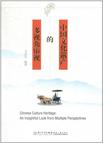中国文化遗产的多视角审视
出版时间:2010-12 出版社:韦忠生 厦门大学出版社 (2010-12出版) 作者:韦忠生 页数:329
内容概要
文化概念是英国人类学家爱德华·泰勒1871年提出的。他将文化定义为“包括知识、信仰、艺术、法律、道德、风俗以及作为一个社会成员所获得的能力与习惯的复杂整体”。
作者简介
韦忠生,男,硕士,福建师范大学福清分校副教授,副译审。在各类学术刊物发表沦文近二十篇,发表译作十余篇,主要从事中西文化研究以及翻译理论和实践研究。现主持福建省教育厅A类社会科学研究项目:接受美学视域下的对外宣传翻译策略f2010.08-2012.03。项目编号:JA10314S)。2007年3月-2009年4月加拿大多伦多市访学。
书籍目录
Chapter One Understand Culture1.1 The Definition of Culture1.2 Layers of Culture1.3 Differences between Cultures: High and Low Context Communication1.4 Measuring Cultural Differences1.5 Cultural Ethnocentrism1.6 Models of Culture1.7 Characteristics of Culture1.8 Approaches to Culture from Different Perspectives1.9 Cultural Competence1.10 Cultural Intelligence1.11 The Process of Developing Cultural Intelligence1.12 Activities That Support the Development of Cultural Intelligence1.13 Cross-Cultural Interactions at HomeChapter Two Understand Chinese Culture from Different Perspective2.1 The General Characteristics of Chinese Civilisation and Culture2.2 An Examination of Traditional Chinese Culture2.3 A Comparision of Chinese Values and Western Values2.4 Four Princioles of Chinese Culture2.5 The Role of Writing in the Formation of Chinese Civilisation and Culture2.6 The Conditions of Civilisation and Its Relation with Culture Chapter Three Ancient China's Four Great Inventions——The Backbone of Chinese Culture3.1 China-A Land of Inventions and Discoveries3.2 Joseph Needham and History of Science and Technology in China3.3 China's Four Great Inventions and Their Impact on the World 3.4 Features of Ancient Chinese Science and Technology3.5 Scientific and Technological Classics3.6 Reasons for Scientific and Technological Stagnation: DifferentChapter Four Historical Background for Chinese Culture——the Prerequisite of Chinese Culture4.1 The ancient period (ancient times——1840)4.2 The modern period(1840-present)Chapter Five An Insightful Look into Various Aspects of Chinese Culture:Chinese Architecture5.1 Three Stages of China's Architecture History5.2 Characteristics of Ancient Chinese Architecture: Different Perspective5.3 Basic Architectural Elements5.4 The Curved Roof : Practical and Aesthetic Consideration5.5 Symbolism in Chinese Architecture5.6 Comparisons Between Ancient Chinese City Planning and European Counterparts5.7 Religious Impact on Ancient European Architecture and Its Features5.8 Fujian (Yongding) Earth Buildings: A Typical Example of Local Residential ArchitectureChapter Six An Insightful Look into Various Aspects of Chinese Culture:Chinese Garden, Potted Landscapes and Tea6.1 A Brief History of Chinese Garden6.2 Classification and Distribution of Chinese Gardens6.3 The Principles of Chinese Garden Design6.4 The Common Structures and Basic Features of Chinese Gardens 6.5 The Aesthetic Features of Chinese Gardens6.6 Differences Between Chinese and Western Gardens6.7 Potted Landscapes: Penjing……Chapter Seven An Insightful Look into Various Aspects of Chinese Culture:Silk & Chinese Culinary Art ...Chapter Eight An Insightful Look into Various Aspects of Chinese Culture:Traditional Chinese Painting & CamgraphyChapter Nine An Insightful Look into Various Aspects of Chinese Culture:Folk Beliefs in Chinese and Western CultureChapter Ten Managing Across CultureChapter Eleven The Integration, Conflict and Translation of Culture,and the Future of Chinese CultureReference
章节摘录
版权页:Each civilization has its own unique cultural system and individual socialcharacteristics. Historically, great differences have existed in the orientation ofculture and values between East and West. The West advocates the use of fire andpreservation of power, while China is characterized as peaceful, gentle and kind,firm yet tenacious. Tea, which is also gentle and peaceful, has been influenced byphilosophy and religion in accordance with these characteristics. Though Taoism andBuddhism have played important roles in the development of tea culture, Confucianthought is regarded as the core of the spirit of the Chinese tea ceremony.It has often been said that Western civilization is open and enthusiastic. Theculture of wine is synonymous with the West. The cultures of the East, such asChina and Japan, possess a disposition resembling tea: sober, sensible, gentle, andenduring. Similarly, Chinese culture emphasizes the development of human relationsin a collective——as opposed to strictly individual manner. This is a key Confucianconcept which was introduced into the tea ceremony, advocating the creation ofharmonious atmosphere through the drinking of tea. In ancient China, foreignenvoys were served tea at the imperial court, while even today, tea is offered informal and informal settings as a way to express friendliness and sincerity, as wellas to strengthen solidarity. Such rituals extend to nearly every aspect of Chineseculture. According to Taoist beliefs, tea can contribute to good health and a longlife. The main underlying percept of Taoism is to discard all desires and worriesform one's mind. Because tea fits with this ethic perfectly, it becomes an essentialcomponent of Taoism. Why the Chinese people connect their belief in the legends ofthe immortals? According to Taoist theory, human vitality lies within collateralchannels. Tea acts as a filter——absorbing impurities while helping to dredge or clearaway these channels of energy. In addition, tea, which allows one to relax withoutfeeling the ill effects of intoxication, is deemed a necessity to the practice of Taoismor Buddhism, since both advocate sitting in meditation. Thus, the effect of teadrinking is connected with the oldest Chinese philosophy, including its rules ofkeeping and maintaining good health, together with a personal elevation within thegreater spiritual sphere.
编辑推荐
《中国文化遗产的多视角审视》由厦门大学出版社出版。
图书封面
评论、评分、阅读与下载
用户评论 (总计0条)
相关图书
- 博目地球仪
- 金贤姬自传
- 龍狼伝 中原繚乱編
- WE Love Smart Phone―HELLO KITTY×dazzlin iPhone4専用コラボカバーつき iPhone特集forGIRLS
- 黒い手帖(中公文庫)
- 日本文学史 - 近世篇二(中公文庫)
- あかねいろー池上茜アートワークスー
- 四国道路地図 3版―高松?徳島?松山?高知
- 東京の歩き方2012
- 北海道の歩き方2012
- ZAKKA BOOKザ?ベスト 2011
- 日本映画magazine vol.19
- 遙かなる時空の中で5 メモリアルブック 完全設定資料集
- ヴァリアブルファイター・マスターファイル VF-1バルキリー 宇宙の翼 VF-1バルキリー Vol.2
- 銃?病原菌?鉄〈上巻〉―1万3000年にわたる人類史の謎
- 嵐のいる風景
- メイプルシロップ
- 景观设计原理
- 风险管理(第11辑)
- 中国企业家列传(第二卷)
- 生活的准则-2010获奖作文集锦
- 水与健康
- 镇长
- 老年护理学
- 精神科护理学
